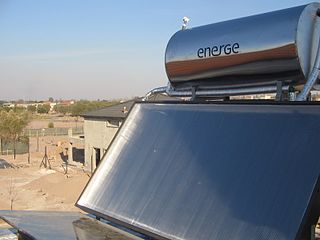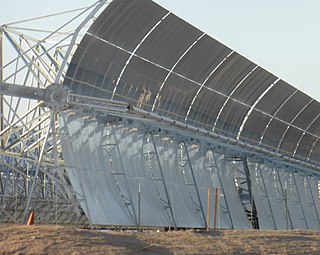
A power station, also referred to as a power plant and sometimes generating station or generating plant, is an industrial facility for the generation of electric power. Power stations are generally connected to an electrical grid.

Solar thermal energy (STE) is a form of energy and a technology for harnessing solar energy to generate thermal energy for use in industry, and in the residential and commercial sectors. Solar thermal collectors are classified by the United States Energy Information Administration as low-, medium-, or high-temperature collectors. Low-temperature collectors are generally unglazed and used to heat swimming pools or to heat ventilation air. Medium-temperature collectors are also usually flat plates but are used for heating water or air for residential and commercial use.

The Rankine cycle is an idealized thermodynamic cycle describing the process by which certain heat engines, such as steam turbines or reciprocating steam engines, allow mechanical work to be extracted from a fluid as it moves between a heat source and heat sink. The Rankine cycle is named after William John Macquorn Rankine, a Scottish polymath professor at Glasgow University.

Solar Energy Generating Systems (SEGS) is a concentrated solar power plant in California, United States. With the combined capacity from three separate locations at 354 megawatt (MW), it was for thirty years the world's largest solar thermal energy generating facility, until the commissioning of the even larger Ivanpah facility in 2014. It was also for thirty years the world's largest solar generating facility of any type of technology, until the commissioning of the photovoltaic Topaz Solar Farm in 2014. It consisted of nine solar power plants in California's Mojave Desert, where insolation is among the best available in the United States.

A thermal power station, also known as a thermal power plant, is a type of power station in which the heat energy generated from various fuel sources is converted to electrical energy. The heat from the source is converted into mechanical energy using a thermodynamic power cycle. The most common cycle involves a working fluid heated and boiled under high pressure in a pressure vessel to produce high-pressure steam. This high pressure-steam is then directed to a turbine, where it rotates the turbine's blades. The rotating turbine is mechanically connected to an electric generator which converts rotary motion into electricity. Fuels such as natural gas or oil can also be burnt directly in gas turbines, skipping the steam generation step. These plants can be of the open cycle or the more efficient combined cycle type.

Nevada Solar One is a concentrated solar power plant, with a nominal capacity of 64 MW and maximum steam turbine power output up to 72 MW net (75 MW gross), spread over an area of 400 acres (160 ha). The projected CO2 emissions avoided are equivalent to taking approximately 20,000 cars off the road. The project required an investment of $266 million USD, and the project officially went into operation in June 2007. Electricity production is estimated to be 134 GWh (gigawatt hours) per year.

There are several solar power plants in the Mojave Desert which supply power to the electricity grid. Insolation in the Mojave Desert is among the best available in the United States, and some significant population centers are located in the area. These plants can generally be built in a few years because solar plants are built almost entirely with modular, readily available materials. Solar Energy Generating Systems (SEGS) is the name given to nine solar power plants in the Mojave Desert which were built in the 1980s, the first commercial solar plant. These plants have a combined capacity of 354 megawatts (MW) which made them the largest solar power installation in the world, until Ivanpah Solar Power Facility was finished in 2014.

The PS10 Solar Power Plant, is the world's first commercial concentrating solar power tower operating near Seville, in Andalusia, Spain. The 11 megawatt (MW) solar power tower produces electricity with 624 large movable mirrors called heliostats. It took four years to build and so far has cost €35 million (US$46 million). PS10 produces about 23,400 megawatt-hours (MW·h) per year, for which it receives €271 (US$360) per MW·h under its power purchase agreement, equating to a revenue of €6.3 million per year.

The Kogan Creek Power Station is a 750 megawatt coal fired power station owned by CS Energy on the Darling Downs in Queensland. The $1.2 billion plant is situated at Brigalow, in the Surat Basin between Dalby and Chinchilla.
Sopogy short for Solar Power Technology was a solar thermal technology supplier founded in 2002 at the Honolulu, Hawaii-based clean technology incubator known as Energy Laboratories. The company began its research on concentrating solar thermal energy to produce solar steam and thermal heat for absorption chillers or industrial process heat. The company has also developed applications that incorporate its solar collectors to generate electricity and desalination. Sopogy's name origin comes from industry key words "So" from solar "po" from power and "gy" from energy and technology. The company has its OEM and IPP sales teams along with research and development located in Honolulu, and in 2006 expanded its manufacturing, C&I and oil and gas sales teams in its Silicon Valley facility. Pacific Business News and Greentech Media reported that the VC-funded micro-concentrator solar power firm was shutting down operations based on statements from its President David Fernandez, however Hitachi Power Systems acquired Sopogy in a private transaction in 2014.

Concentrated solar power systems generate solar power by using mirrors or lenses to concentrate a large area of sunlight into a receiver. Electricity is generated when the concentrated light is converted to heat, which drives a heat engine connected to an electrical power generator or powers a thermochemical reaction.

eSolar is a privately held company that develops concentrating solar power (CSP) plant technology. The company was founded by the Pasadena-based business incubator Idealab in 2007 as a developer of CSP plant technology. The company aims to develop a low cost alternative to fossil fuels through a combination of small heliostats, modular architecture, and a high-precision sun-tracking system. In October 2017, an article in GreenTech Media suggested that eSolar ceased business in late 2016.
A compact linear Fresnel reflector (CLFR) – also referred to as a concentrating linear Fresnel reflector – is a specific type of linear Fresnel reflector (LFR) technology. They are named for their similarity to a Fresnel lens, in which many small, thin lens fragments are combined to simulate a much thicker simple lens. These mirrors are capable of concentrating the sun's energy to approximately 30 times its normal intensity.

The Ivanpah Solar Electric Generating System is a concentrated solar thermal plant in the Mojave Desert. It is located at the base of Clark Mountain in California, across the state line from Primm, Nevada. The plant has a gross capacity of 392 megawatts (MW). It uses 173,500 heliostats, each with two mirrors focusing solar energy on boilers located on three 459-foot-tall (140 m) solar power towers. The first unit of the system was connected to the electrical grid in September 2013 for an initial synchronization test. The facility formally opened on February 13, 2014. In 2014, it was the world's largest solar thermal power station.

Sierra SunTower was a 5 MW commercial concentrating solar power (CSP) plant built and operated by eSolar. The plant is located in Lancaster, California. As of mid-September, 2022, the two towers that were the center of the facility are no longer standing. However the rest of the plant is still present.
Holaniku at Keahole Point is a 2MW micro-scaled concentrated solar power plant in the Kona District of the island of Hawaiʻi. It is located in the Natural Energy Laboratory of Hawaii at Keahole Point.
Areva Solar was part of the renewable energies portfolio of the French nuclear group Areva, headquartered in Mountain View, California, with offices in the United States and Australia. It designed, manufactured and installed solar steam generators for electric power production and industrial steam uses. Before 2010, the company existed as Ausra Inc. In August 2014, AREVA announced it was shuttering AREVA Solar.

The Mojave Solar Project (MSP) is a concentrated solar power (CSP) facility in the Mojave Desert in California, about 20 miles (32 km) northwest of Barstow. Surrounding the hamlet of Lockhart, Mojave Solar is adjacent to Harper Lake and the SEGS VIII–IX solar plant.

Khi Solar One (KSO) is a solar power tower solar thermal power plant, located in the Northern Cape Region of South Africa. Khi Solar One is 50 megawatts (MW), and is the first solar tower plant in Africa. It covers an area of 140 hectares.
Termosolar Borges is a hybrid biomass-parabolic trough solar thermal power plant which provides electricity to Spain's transmission system. It is located about 100 kilometres (62 mi) west of Barcelona, about 10 kilometres (6.2 mi) south-east of Lleida, near Les Borges Blanques, Catalonia, Spain.













